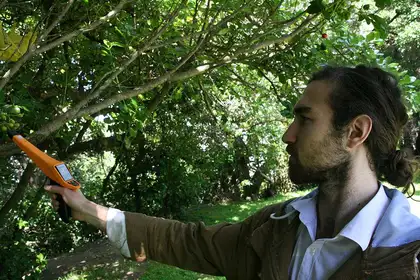
Industrial designer William Lockwood-Geck demonstrates his device the Harvest Manager 300 that measures the quality of kiwifruit In New Zealand orchards.
Kiwifruit growers could have a new and productive tool at their disposal. Industrial designer William Lockwood-Geck’s hand-held scanner which measures the quality of the fruit, is already attracting attention.
Called the Harvest Manager 300, the scanner helps growers identify when the fruit is ready to be picked and also promises to be a cost-saving as much as a time-saving device.
His conceptual design is part of the end-of-year Exposure exhibition being staged by final year students at Massey University’s College of Creative Arts, which opens at the Wellington campus on Friday.
Under horticultural regulations, the New Zealand kiwifruit sector requires kiwifruit growers to pay $300 for a quality test to ensure the fruit meets minimum taste standards before it can be harvested from March till May each year. Tests are required for each part of an orchard. These parts are defined as maturity areas, which can include areas of different age or varieties that grow either green or gold kiwifruit.
The tests are needed as growers have to guess when their fruit has sufficient dry matter (the fruit’s substance, including the sugars, minus the water), Mr Lockwood-Geck says.
Most growers need at least two or three quality tests taken per area, with some larger orchards needing as many as seven, significantly raising the cost of testing, he says.
“The HM300 removes the guesswork and allows growers the need to purchase only one $300 test per area.”
The front end of the device rests against the skin of the hanging fruit, transferring the data to a display that is angled to face the user. The process only takes milliseconds and data can later be transferred to a computer or smart device.
The information transferred can be used to determine the fruits taste levels, for which the sector provides different levels of taste payment – an incentive to growers to focus on growing higher quality fruit, rather than on producing high volumes of fruit. The information allows growers to better determine when it is the best possible time to pick their fruit to receive maximum taste payments.
“Knowing what time to pick your fruit can dramatically change the amount of money you earn from your orchard,” Mr Lockwood-Geck says.
While other fruit industries operate similar, but not identical, technology no existing products have the ergonomic benefits of the scanner, he says.
His design, featuring an angled handle, nozzle and screen to allow the users wrists and head to be in neutral positions when taking measurements, ensures that orchardists are not in such stress positions for long periods.
“The long length of the nozzle also allows users to keep their elbows below shoulder height when reaching up to the canopy. This prevents damage to the shoulder and elbow joints and allows the heart to pump blood to the arm with greater ease.”
Mr Lockwood-Geck, who is originally from Cambridge, and grew up and worked on orchards from an early age, says his design has already attracted interest from growers and the next step was determining what further opportunity there was within the horticultural sector to progress his design.
As part of his extensive research for his final-year industrial design project he held discussions with a horticultural company manager, talked to growers as well as kiwifruit consultants and gauged the reaction of orchard staff supervisors too.
“It’s all about helping growers make good decisions when they harvest,” he says.